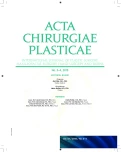A-13 BARRIER EFFICIENCY OF POLYURETHANE FOIL IN PREVENTION OF POSTOPERATIVE INFECTION IN FREE MUSCLE FLAPS
Authors:
K. Podskalská Sommerová; B. Zálešák; D. Stehlik; R. Lysák
Authors‘ workplace:
Department of Plastic and Aesthetic Surgery, University Hospital in Olomouc, Czech Republic
Published in:
ACTA CHIRURGIAE PLASTICAE, 57, 3-4, 2015, pp. 65-67
Category:
Selected abstracts from the 36th national congress of the czech society plastic surgery with international participation
Introduction
The authors present long term experience with the use of polyurethane foils (PUF) for coverage of free muscle flaps in early postoperative period. They analyze the occurrence of infectious complications in each group of patients according to the method of flap coverage.
Method
Foils have been used at the Department of Plastic and Aesthetic Surgery University Hospital in Olomouc for coverage of free flaps since 2004. We were interested whether the occurrence of infection or bacterial contamination of flaps is really lower in the group of patients, in whom was used sterile foil, and we decided to objectivize this hypothesis. Data was obtained retrospectively from available medical documentation. Since the year 2000 till 2015 were performed transfers of totally 105 free muscle flaps. The group does not include musculocutaneous flaps. 26 patients underwent primary transplantation of split thickness skin grafts (SSG) and for coverage of flaps was used conventional dressing. Often there was Persteril soaked dressing in one-thousandthdilution used for prevention of infection locally. Since the year 2004 we performed primary transplantation of the flap with SSG in 24 patients and instead of conventional dressing we used a sterile foil. With regards to greater percentage of secondary transplantations due to the lack of grafttake, we gradually stopped using this method. In 55 patients was the muscle flap covered with sterile polyurethane foil immediately after the procedure and SSG was applied later, usually on the 9th postoperative day (6th–20th postoperative day). Application of a foil is performed as follows: initially we treat the surrounding skin with ether to improve adherence of foil to the skin by removal of grease. Skin must be completely dry when the foil is applied. Prophylaxis of infection is enhanced with application of a thin layer of sterile eye ointment with antibiotic on top of the muscle flap. During application of the foil we make sure that there was sufficient overlap of the foil over the surrounding skin and that it was completely freely applied without any tension. Excessive tension on the foil with regards to its elasticity could result in constriction of the flap during swelling. Foil is left on the flap for 5-8 days without a change of dressing, often until the secondary transplantation with a SSG.
Results
The greatest percentage of retransplantations (30.7%) was noted in the group with primary transplantations of the flap with SSG and during the use of conventional dressing. The lowest percentage of SSG necroses (1.8%) was in the group when PUF was used and secondary transplantation performed. Percentage of infections of the flap was relatively high in all groups, from 11.5–18.5%. With regards to high percentage of infectious complications in group B1 and B2, i.e. during the use of PUF, we performed detailed analysis of each case of these two groups of patients. There were totally 14 patients with flap infection (17.7%). We found that in 11 patients from the group, there was microbial contamination of the defect caused by the same bacterial strain than before the operation. These were mainly patients with defects after open fractures of the lower limbs, with chronic osteomyelitis, resistant postirradiation defects and patients with diabetes. One case was a patient with immunosupression who was colonized with Pseudomonas, which was cultured from the airways, urine and swab from the muscle flap. The most frequent bacterial agent was Staphylococcus aureus, Pseudomonas aeruginosa and Enterococcus. From the total number of 79 patients in the group B1 and B2, infection occurred after operation only in two patients (2.53%).
Discussion
Polyurethane foil is thin transparent membrane that is coated with a layer of acryl to ensure its adherence. It is sterile, elastic and resistant against pulling, moreover it is hypoallergic and it does not contain any latex. Another important feature is its semipermeability. It creates a semiocclusive membrane, which is not permeable for fluids, bacteria and viruses, but it is readily permeable for gasses. Its transparency enables comfortable clinical and Doppler monitoring of free muscle flaps in critical early postoperative period. It also creates an effective barrier against infection, external contamination, when the most frequent route of transfer of hospital acquired infection is the hand of a health care personnel. It also maintains moist environment in the wound and prevents drying of tissues. The foil may be left on the flap without any change of dressing for several days and without further dressing, and thereby it reduces the financial burden for dressing therapy and saves time of health care personnel.
Conclusion
According to our experience, sterile polyurethane foil is an ideal coverage of free muscle flaps. This is a safe and elegant method with low percentage of infectious complications. (Table 13.1, 13.2, Fig. 13.1, 13.2.)



Labels
Plastic surgery Orthopaedics Burns medicine TraumatologyArticle was published in
Acta chirurgiae plasticae

2015 Issue 3-4
Most read in this issue
- 36th NATIONAL CONGRESS OF THE CZECH SOCIETY OF PLASTIC SURGERY WITH INTERNATIONAL PARTICIPATION
-
ZORA JANŽEKOVIČ
(September 30, 1918 – March 17, 2015) - Dorsoradial forearm flap with silicone bone spacer in reconstruction of A combined THUMB injury – case report
- Editorial

